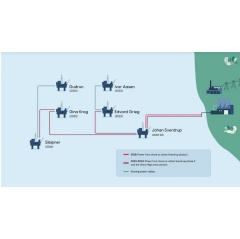Reducing emissions from Sleipner and Gudrun
The Sleipner field centre, along with the Gudrun platform and other associated fields, is now partly operating on power from shore. This will reduce annual emissions from the Norwegian continental shelf (NCS) by 160,000 tonnes of CO2.
All installations on the Utsira High are now receiving power from shore, saving emissions amounting to about 1.2 million tonnes of CO₂ per year. The electrification of the installations on the Utsira High is in line with the plan for development and operation (PDO) for Johan Sverdrup phase 2, which was approved by the Norwegian parliament in 2019.
“Electrification is the most effective tool in our toolbox in our quest to achieve the national target of halving greenhouse gas emissions from Norwegian oil and gas production by 2030,” says Geir Tungesvik, executive vice president for Projects, Drilling & Procurement.
One of two operative gas turbines on the Sleipner A platform will gradually be shut down as a relevant systems transition to using power from shore. The other gas turbine will stand by as a back-up power source during a run-in phase. In the longer run, Sleipner will have the opportunity to fully operate on power from shore.
The Sleipner field centre has been supplied with onshore power via a cable from the Gina Krog platform. Starting on the same date, the Gudrun platform was connected to electricity through the existing cable to Sleipner.
“The Sleipner area has delivered vast volumes of energy, created long-term ripple effects and contributed substantial values to the Norwegian society. With power from shore, we can develop new discoveries and resources from low-emission production, and gas export from the area can be maintained for a long time to come,” says Kjetil Hove, executive vice president for Exploration & Production Norway.
The Sleipner fields are among the largest gas producers in the North Sea and serve as a hub for gas transport to Europe. Norwegian gas plays an important role in the EU’s energy transition. Now, also the gas that would otherwise be burnt on the installations can be utilised more effectively in Europe.
“The electrification of the Sleipner field centre has created important jobs and ripple effects for the Norwegian supply industry. I’m also very pleased with that we, our partners, and suppliers, have succeeded in implementing the project safely, with zero HSE incidents,” Tungesvik says.
Overall investments in the project total NOK 1.08 billion.
In 2020, the Sleipner partnership exercised an option with Aibel for an EPCIC contract (engineering, procurement, construction, installation and commissioning) for the modification work on the Sleipner field centre. NKT was awarded the contract to manufacture and lay the power cables.
The EPCIC contract has a value of about NOK 700 million and has contributed to 250 full-time equivalents at Aibel’s Stavanger office, offshore and at the shipyard in Haugesund. ABB has carried out substantial work as a sub-contractor within installation of high-voltage equipment and updating the power control system.
Facts- Partial electrification of the Sleipner field centre and Gudrun platform will reduce annual emissions from the NCS by 160,000 tonnes of CO2.
- The project also helps reduce Nox emissions in the order of 700 tonnes per year.
- The Sleipner field centre is supplied with onshore power via a 28-km long cable from the Gina Krog platform, which is connected to Johan Sverdrup with onshore power. The Gina Krog platform was connected to onshore power in September 2023.
- Overall investments in the project total NOK 1.08 billion.
- A total of about 500,000 hours have been worked, approx. 200,000 of which took place offshore, without any unwanted HSE incidents.
- The Sleipner field has removed CO2 from produced gas, captured, injected and stored around 20 million tonnes of CO2 since the start in 1996.
- The licensees in the Sleipner East licence are Equinor Energy AS (operator, 59.6%), Vår Energi ASA (15.4%), PGNiG Upstream Norway AS (15.0%) and Orlen Upstream Norway 2 AS (10.0%).
- The licensees in the Gudrun licence are Equinor Energy AS (operator, 36.0%), Vår Energi Norge AS (25.0%), OMV (Norge) AS (24.0%) and Repsol Norway AS (15.0%).
- With the entire Utsira High now electrified, emissions amounting to approximately 1.2 million tonnes per year is saved.
- The Utsira High power grid includes the following installations: Johan Sverdrup, Gina Krog, Sleipner, Gudrun (all operated by Equinor), Edvard Grieg and Ivar Aasen (both operated by Aker BP).
( Press Release Image: https://photos.webwire.com/prmedia/7/320231/320231-1.jpg )
WebWireID320231
This news content was configured by WebWire editorial staff. Linking is permitted.
News Release Distribution and Press Release Distribution Services Provided by WebWire.
